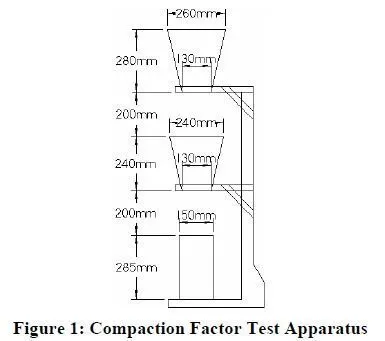The inverted slump cone test (Tattersall and Banfill 1983; McWhannell 1994; Johnston 1994; ASTM C995-01; Bartos, Sonebi, and Tamimi 2002) was developed as a simple and inexpensive field test to measure the workability of fiber-reinforced concrete. Although fiber-reinforced concrete can show increased workability, the individual fibers act to increase concrete thixotropy. McWhannell (1994) has shown that mixes incorporating polypropylene fibers show a slight decrease in slump but an increase in workability as measured with the compacting factor test. Indeed, SI Concrete Systems, a large manufacturer of steel and synthetic fibers for concrete, advises against using the slump test for measuring the workability of fiber-reinforced concrete.
The test apparatus is comprised of readily available jobsite equipment an internal vibrator, slump cone, and bucket. The test is standardized in ASTM C995: Standard Test Method for Time of Flow of Fiber-Reinforced Concrete through Inverted Slump Cone. A specially constructed wood frame, shown in Figure 13, holds the slump cone in an inverted position above the standard bucket described in ASTM C29/C29M for determination of unit weight. A 4 inch gap is left between the bottom of the inverted slump cone and the bottom of the bucket. The dampened slump cone is then filled with concrete in three layers. Although the concrete should not be compacted, each layer of concrete should be leveled off to minimize entrapped air. To keep the concrete from falling through the bottom of the slump cone, the ASTM standard recommends placing a sufficiently large volume of concrete in the bottom of the cone to bridge the opening. With the slump cone full and leveled off at the top, a one-inch diameter internal vibrator is inserted into the top of the concrete and allowed to descend at a rate such that the vibrator comes into contact with the bottom of the bucket in 3 +/- 1s. The vibrator is then held in a vertical position and the total elapsed time from the insertion of the vibrator until all the concrete has passed out of the slump cone is recorded.
ACI Committee 544 (1989) on fiber-reinforced concrete recommends the use of the inverted slump cone test. The use of vibration has been deemed appropriate since the fiber-reinforced concretes that are tested with the inverted slump cone test are commonly vibrated during placement. Research has shown that the inverted slump cone test can successfully detect changes in coarse aggregate fraction, fiber content, fiber length, and fiber aspect ratio (Johnston 1994).

Although the test is improvements on static tests that do not take into account the higher thixotropy of fiber-reinforced concrete, the inverted slump cone test has several important restrictions on its usefulness. The test applies only to concretes with flow times greater than 8 seconds and slumps less than 2 inches. More fluid concretes can flow through the bottom of the cone without vibration and cannot be measured with sufficient precision. The size of the apparatus also restricts the use of some concretes. The small gap of 1 ½ inches around the vibrator at the bottom of the cone limits the maximum aggregate size and the use of long, stiff fibers with high aspect ratios. Tattersall and Banfill (1983) state that the gap between the cone and vibrator should be 10 times the maximum aggregate size. Additionally, long fibrillated and monofilament fibers can wrap around the vibrator and distort results. In order to allow the use of readily available job equipment to conduct the test, the ASTM standard only specifies that the internal vibrator be 1 +/- 1/8 inch in diameter. Variations in the diameter, frequency, and amplitude of the vibrator prevent the direct comparison of test results and the development of specifications for fiber-reinforced concrete in terms of inverted slump cone time. The precision of the test is influenced by operator error in properly inserting the vibrator and determining the correct start and stop times for the test. Since the concrete is not consolidated prior to the start of the test, the cone can contain large volumes of entrapped air.
Advantages:
The inverted slump cone test is a dynamic test that takes into account the high thixotropy of fiber-reinforced concrete.
The test is simple and provides a direct result.
The test apparatus consists of readily available equipment.
Disadvantages:
The test is only appropriate for concrete mixes with a slump of less than 2 inches.
The test is difficult to perform. Filling the inverted slump cone with concrete so that no concrete falls through the hole is tricky. Further, the vibrator must be inserted directly down the center of the inverted slump cone in a certain period of time.
The gap at the bottom of the inverted slump cone is too small based on typical aggregate sizes and some fiber lengths.
Some long fibers may wrap around the vibrator.
Important test parameters are not standardized; therefore, tests conducted with different vibrators cannot be compared. Likewise, it is difficult to write specifications in terms of inverted slump cone time.
Operator error is introduced in determining the exact stopping point of the test.
